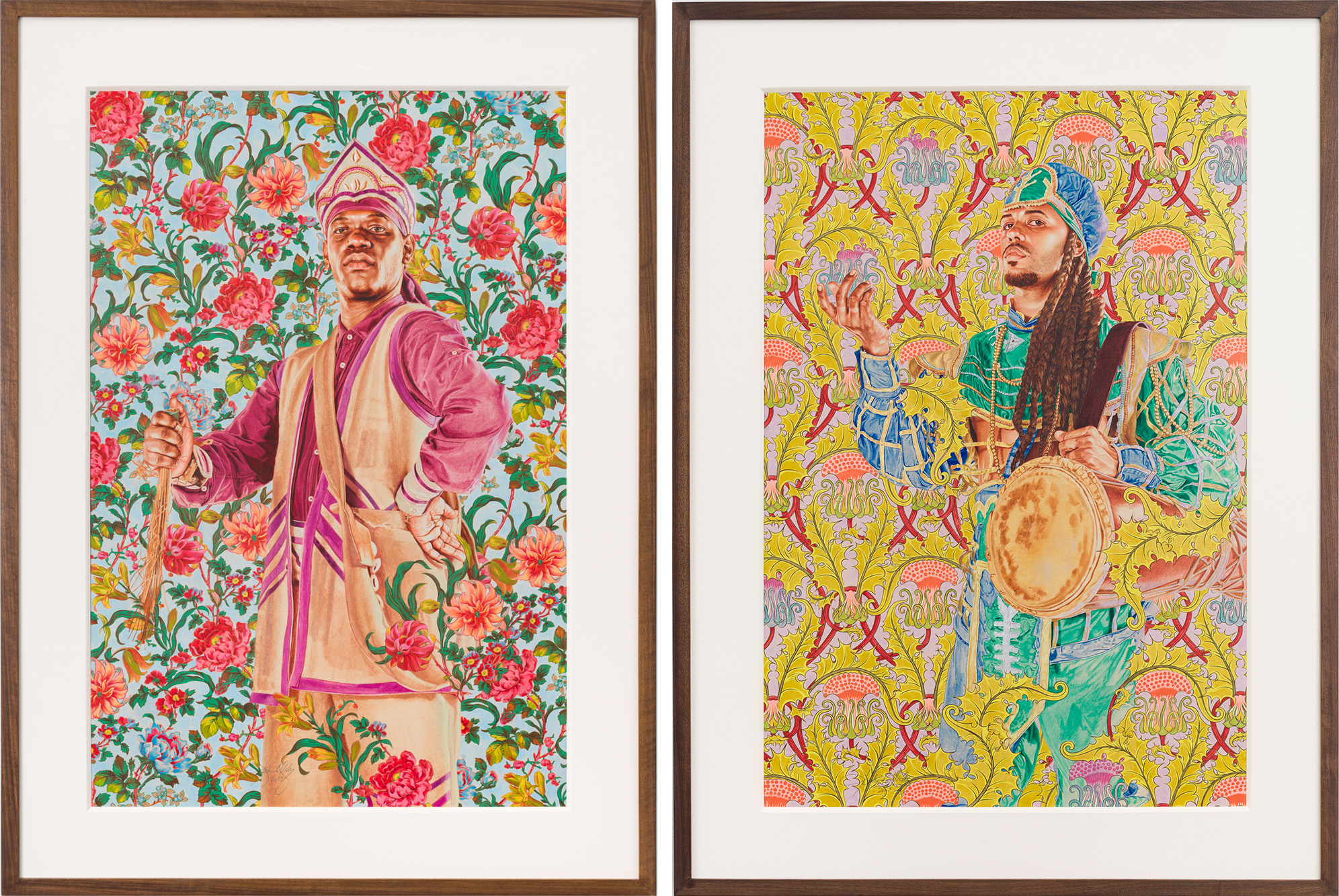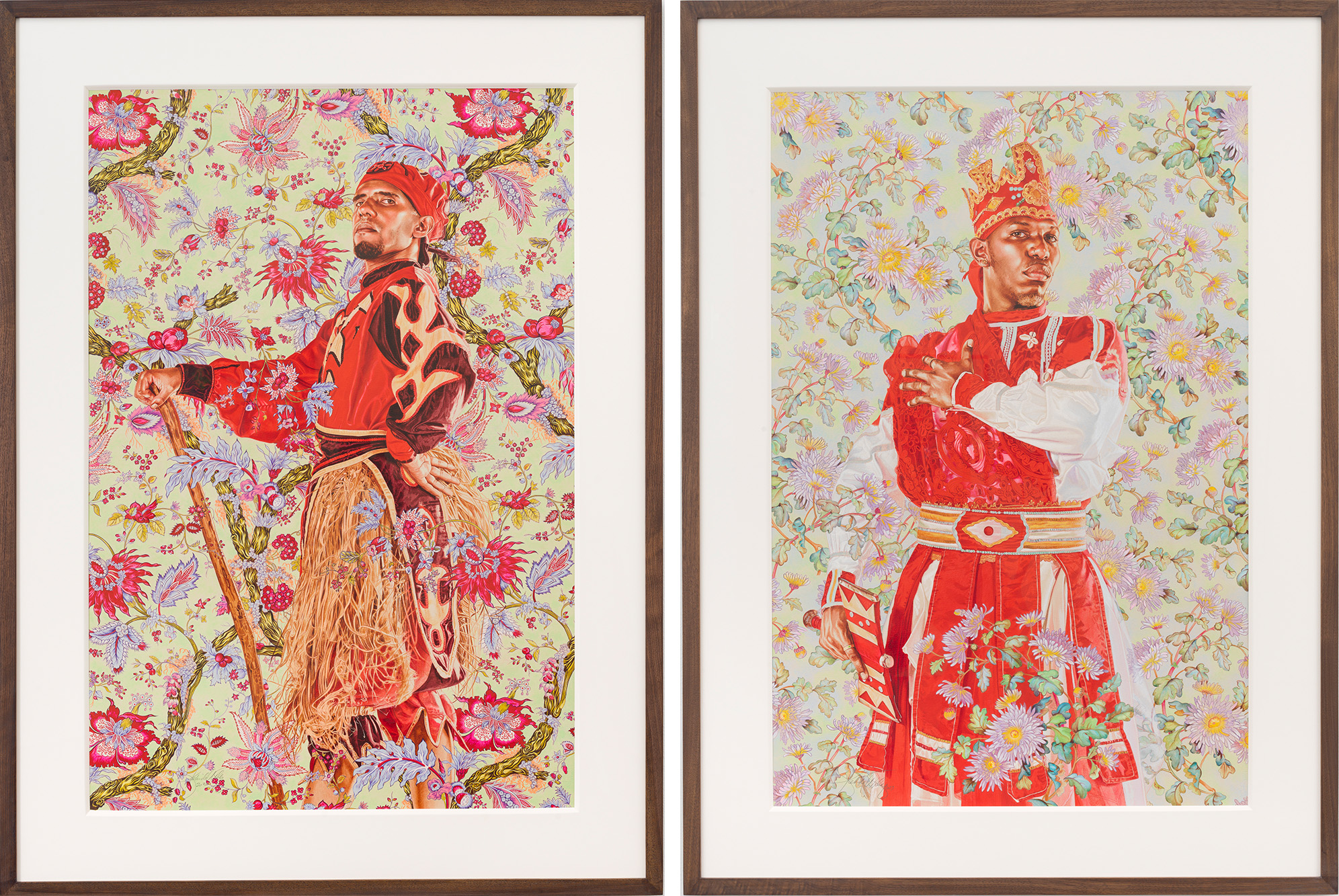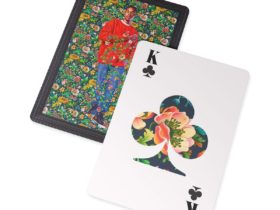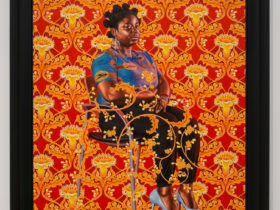Art
#carnival
#Cuba
#Kehinde Wiley
#oil painting
#painting
#portraits
Cuba and the Carnivalesque Take Center Stage in Kehinde Wiley’s New Portrait Series ‘HAVANA’
May 8, 2023
Kate Mothes

“Portrait of Yaima Polledo & Isabel Pozo” (2023), oil on linen, 108 x 81 15/16 inches. Photo by Max Yawney. All images © Kehinde Wiley, shared with permission courtesy of Sean Kelly Gallery
Amidst his signature verdant backdrops, Kehinde Wiley (previously) situates his subjects in the center of the composition, chins tilted up with regal gazes, enveloped in the grandeur of colorful patterns. The artist is known for monumental portraits in oil that reframe European painting traditions, especially referencing court portraiture in which royal or noble families—almost exclusively white—were portrayed in extravagant dress symbolizing wealth and power. Wiley flips the narrative by positioning historically marginalized Black and Brown figures front and center.
Wiley’s latest body of work titled HAVANA, on view now at Sean Kelly in New York, continues the artist’s interest in the cultures and traditions of the African diaspora. He draws on two separate visits to Cuba, first in 2015 and again in 2022, exploring the carnivalesque phenomenon in Western culture, which manifests in numerous colorful, celebratory events around the world, such as Mardi Gras in New Orleans. Wearing layers of vivid fabric and carrying juggling sticks or instruments, Wiley captures the individuality and creative focus of each person. He says:
The performers are each different—there’s so many different points of view, so many different life experiences, but one thing that unites them all is the very sense that America dominates the economic fortune of Cuba. The relationship between America and Cuba is one that has been fraught with a fascination, a suspicion, an intrigue, and a cultural weight.
Wiley references notable artists like Henri Toulouse-Lautrec, Pablo Picasso, and Alexander Calder, who around the turn of the 20th century explored similar themes. Through portraits of acrobats, dancers, and musicians, Wiley examines the political history, economic hardship, and thirst for artistic freedom in Cuba, focusing on circuses and carnivals as sites of celebration, disruption, and self-expression.

“Portrait of Erika Gray Ferro” (2023), oil on linen, 48 x 36 inches. Photo by Max Yawney
On his first visit to Cuba, Wiley stopped by the Escuela Nacional de Circo, or the National Circus School, to learn about the history of the medium in the country and its national circus, Circuba. Prior to the Cuban Revolution, the nation was home to numerous family-run companies, but today, there is only one. During his second visit, he met with members of Raices Profundas, a group regarded as one of the world’s most authentic performing ensembles in the Yoruba tradition.
Like in many parts of the world, numerous cultural histories intersect in Cuba due to the period of European colonization, which resulted in the forced migration of Indigenous populations and centuries of enslavement of African peoples. Over time, circuses and elaborate street parties became “opportunities for the formerly enslaved to engage in moments of freedom and grace that were generally forbidden,” reads an exhibition statement. “The carnival, Mardi Gras, and street processions were events in which chaos could arise, love could be expressed, and a spiritual embrace of religious traditions could be manifest.”
HAVANA continues at Sean Kelly through June 17, which includes a three-channel film featuring some of the performers. See more from the artist on his website or Instagram, and you might also want to check out Big Chief Demond Melancon’s elaborately beaded Mardi Gras costumes.

“Portrait of Rassiel Alfonso Leonard & Nairobys C. Placeres Riviero” (2023), oil on linen, 108 x 72 inches. Photo by Max Yawney

Left: “Evel Antonio Study” (2023), oil on paper, 44 x 30 inches. Right: “Jorge Gonzales Acosta Study” (2023), oil on paper, 44 x 30 inches. Photos by Adam Reich

“Portrait of Yadiel Arrozaceno Dorticós” (2023), oil on linen, 72 x 60 inches

“Portrait of Anet Arias” (2023), oil on linen, 48 x 36 inches. Photo by Max Yawney

“Portrait of Daniel Paiol López” (2023), oil on linen, 96 x 72 inches. Photo by Max Yawney

Left: “Juan Cabrera Pulido Study” (2023), oil on paper, 45 x 31 inches. Right: “Misahel Hernández Study” (2023), oil on paper, 44 x 30 inches. Photos by Adam Reich

“Portrait of Tony di heon Gonzales & Armando Leon Aquirre” (2023), oil on linen, 108 x 72 inches

“Portrait of Juan Cabrera Pulido & Emilio Hernandez Gonzalez” (2023), oil on linen, 108 x 72 inches
#carnival
#Cuba
#Kehinde Wiley
#oil painting
#painting
#portraits
Do stories and artists like this matter to you? Become a Colossal Member today and support independent arts publishing for as little as $5 per month. You’ll connect with a community of like-minded readers who are passionate about contemporary art, read articles and newsletters ad-free, sustain our interview series, get discounts and early access to our limited-edition print releases, and much more. Join now!
Share this story
This article comes from the Internet:Cuba and the Carnivalesque Take Center Stage in Kehinde Wiley’s New Portrait Series ‘HAVANA’






